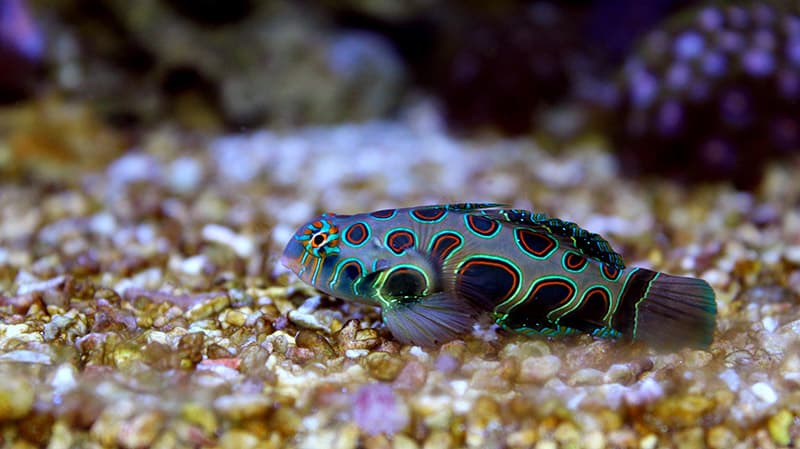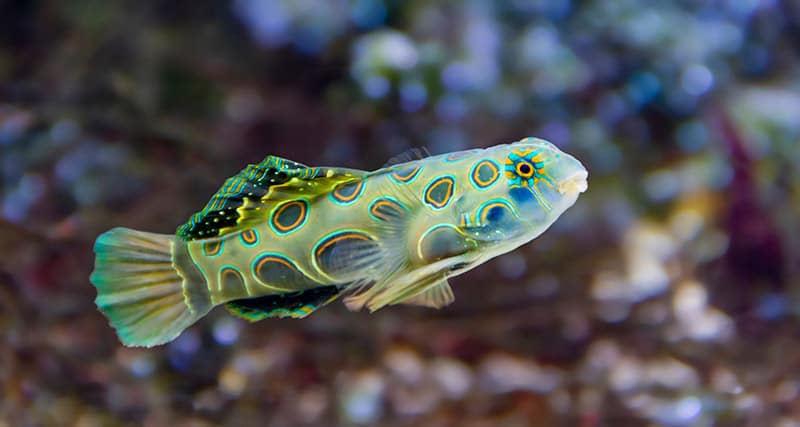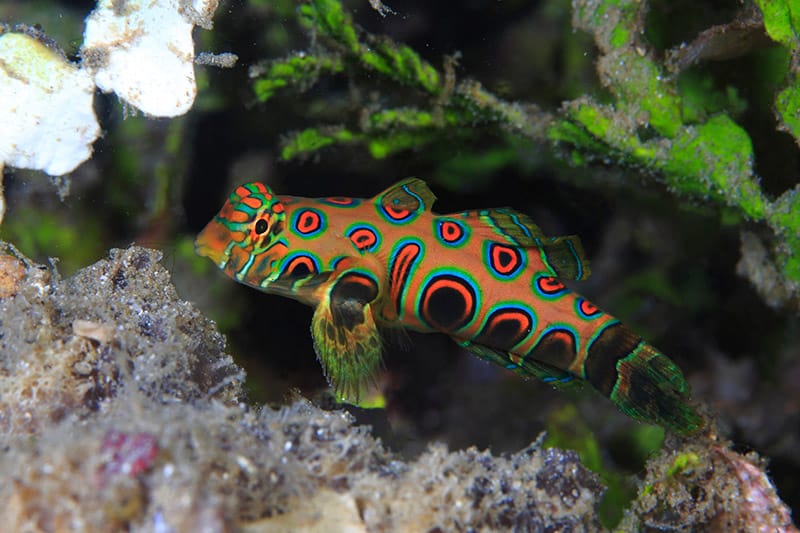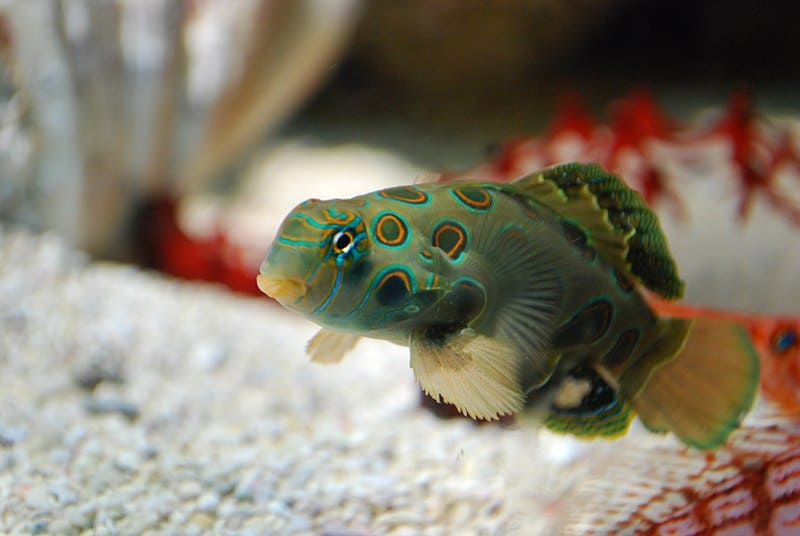A little smaller than their green and blue striped cousin, the Spotted Mandarin is another spectacularly painted dragonet that many aquarist are drawn to!
The elongated body of the Spotted Mandarin is green with darker green circles and irregular ovals all over the body, ending with an irregular vertical bar at the base of the tail fin. These dark green shapes are thinly ringed in a bright orange, dark green ring then a bright turquoise green ring. The pectoral fins are a clearish orange and the pectoral and tail fin is the same green as the body. There are two dorsal fins that carry the same bright colors of the body. On males, the first dorsal fin has an elongated spine which is longer than the female’s, and he is also physically larger. Their head is the same green as the body with thin electric blue and orange lines that run between their eyes and under their chin. Their eyes are orange to red and they have a slight arched bulge that has alternating colors of orange and electric blue to green. The males can grow to 2.8″ (7 cm), which are a little smaller than their striped cousins. Spotted Mandarins and they live 10 to 15 years.
Mandarinfish are often referred to as the Mandarin Goby, however, like the Engineer Goby, neither one is actually a goby! These Dragonets have a less palatable, noxious, mucous layer over their bodiesand are scaleless. At night, they turn pale and sleep on the sand; sometimes half buried. Some have been acclimated to aquarium food, however it takes persistence. They are similar to the Striped Mandarinfish which is larger but has blues, greens and reddish orange coloring.
Spotted Mandarins can be very difficult or quite hardy, depending on the preparation of the aquarist. They are best kept by intermediate to advanced aquarists who can understand their specific needs. Spotted Mandarins are almost immune to Crypt because of their scaleless body and if fed well will live a long life. Because of their scaleless bodies, do not use copper orOrganophosphates (See list under diseases). Do not add your Spotted Mandarin to a sparsely fed or a bare bottomed tank, since copepods and amphipods will not have the food available to reproduce fast enough to keep up with the needs of a hungry Mandarin. Avoid netting them, as their cheek spines will become entangled and can cause injury.
Male and female pairs will often spawn in captivity. They can be kept alone or in a male/female pair, but 2 males will attack each other, unless the tank is very large. Do not house with their striped cousin or other dragnets unless the tanks is hundreds of gallons. Most fish will ignore the Spotted Mandarins due to it’s “leave me alone†coloring, however inverts such as potent sea anemones, especially those found near the bottom of the tank, elephant ear anemones, Elegance Coral (strong sting), large crabs, aggressive fish, fish in the Scorpion family, and mantis shrimp will eat them. These are peaceful, slow moving, methodical eaters which will be outcompeted for food by wrasses from the Halichoeres (huge pod eaters) or Pseudocheilinus genus (lined wrasses).
Make sure your tank has 75+ pounds of established live rock (not base rock) for each Spotted Mandarin. This rock should be seeded well with a good copepod/amphipod population before adding the fish and the tank should be at least 6 months old. These tiny crustaceans will be visible on the rock before you add your mandarin. Provide sand for the substrate for them to hunt and sleep on. Some aquarists have used a ‘pod pile,†which is a few small rocks that are piled up tightly enough to protect most of the pods from predation. Added to the middle of this pile would be a small piece of shrimp, fish flesh or other food every few days so the pods will rapidly breed and come out to be eaten! You can also add a refugium to the tank to keep the pod population up or culture your own pods.
NOTE: Both the spotted and psychedelic mandarinfish thrive only on a large and constant supply of live copepods: interstitial crustacians and worms!
Scientific Classification
| Kingdom: | Animalia |
| Phylum: | Chordata |
| Class: | Actinopterygii |
| Order: | Perciformes |
| Family: | Callionymidae |
| Genus: | Synchiropus |
| Species: | picturatus |
Spotted Mandarin – Quick Aquarium Care
| Aquarist Experience Level: | Intermediate |
| Aquarium Hardiness: | Moderately hardy |
| Minimum Tank Size: | 55 gal (208 L) |
| Size of fish – inches: | 2.8 inches (7.11 cm) |
| Temperament: | Peaceful |
| Temperature: | 72.0 to 84.0° F (22.2 to 28.9° C) |
| Range ph: | 8.1-8.4 |
| Diet Type: | Carnivore |

Habitat: Distribution / Background
The Spotted Mandarins, Synchiropus picturatus, was first described by Peters, in 1877. The genus name, Synchiropus is Greek for “grown together hand and foot.†While the official common name is Picturesque Dragonet, whose coloring resembles the robes of an Imperial Chinese Officer (mandarin), many other names they are known by in the retail world and hobby world. These are Psychedelic Fish, Green Spotted Mandarin, Green Spot Mandarin, Target Mandarin, Picture Dragonet, Spotted Mandarin, Mandarin Dragonet, Mandarinfish, and Mandarin Goby.
Spotted Mandarins are found in the Indo-West Pacific, in the Philippines, eastern Indonesia and Northwest Australia in shallow sheltered reefs, tidal creeks, lagoon patch reefs and mangrove swamps, where there is a sandy bottom. They are found in small loose groups that are spread out over a small territory. The depths they are found are from 3 to 66 feet (1 to 20 meters), feeding on zoo benthos which are small bottom dwelling crustaceans such as various amphipods and copepods.
The Spotted Mandarin has not been evaluated by the IUCN Red List for Endangered Species.
- Scientific Name: Synchiropus picturatus
- Social Grouping: Groups – In the wild they are found in loose groups and come together to spawn once a week, 3 months of the year.
- IUCN Red List: NE – Not Evaluated or not listed
Description
The elongated body of the Spotted Mandarin is green, leaning towards the olive side of green, with various sizes of darker green/olivecircles and irregular ovals all over the body, excluding the head. They have an irregular vertical bar at the base of the tail fin consisting of the same colors as the circles and ovals. These dark green shapes are thinly ringed in a bright orange, followed by another dark green ring and the outermost ring is a bright turquoise green. The pectoral fins are a clearishorange but the pectoral and tail fin is the same green as the body. There are two dorsal fins, that while young, have the beginnings of the spotting pattern, though manifested as bright blue and green dots and dashes. As they mature, the spots found on the body find their way into the dorsal fin area in most specimens. Their head is the same green as the body with thin electric blue and orange lines that run between the eyes and then run under their chin. Their eyes are orange to red and they sit within a slight arched bulge at the top of their head whichhas alternating colors of orange and electric blue to green. Spotted Mandarinshave a protruding mouthadapted for accurate hunting of small benthic crustaceans. For defense, they use their coloring, sharp spines on their cheeks and noxious slime coating. On males, the first dorsal fin has an elongated spine which is much longer than the female’s, and he is also physically larger. The males can grow to 2.8†(7 cm), which are a little smaller than their striped cousins and they will live 10 to 15 years.
- Size of fish – inches: 2.8 inches (7.11 cm)
- Lifespan: 10 years – 10 to 15 years.
Fish Keeping Difficulty
Spotted Mandarins can be difficult to moderately easy to care for, depending on your set up and preparation. Each one of your Spotted Mandarins that you wish to keep should have 75+ pounds of live rock, which would be heavily populated with copepods and amphipods before purchase. Purchase your mandarin as soon as they arrive at the store, yet avoiding any emaciated or very thin specimens, since these individuals are difficult to restore to proper health. To be sure you have a healthy Spotted Mandarin, look at the area behind their pectoral fins, near the bottom of the body. If that is pinched in severely, recovery may not be possible. Order one from your LFS, have them call you when it arrives and before they acclimate it to their system, bring your mandarins home right away and acclimate it as you would a fish that was shipped directly to you. These are one of those rare fish that should be put directly into the main display, unless you have a quarantine tank that is 6 months old and has 75 pounds or more of live rock, with a heavy population of amphipods and copepods.
To adjust them to prepared foods, some aquarists have had success placing a narrow glass bottle filled with pellets or mysis, that other fish cannot get into, on the bottom front of the tank to ensure they are getting enough food. This can be done to train them, however the tank still needs to have plenty of live foods, especially for wild caught specimens. This will allow the long period of time it may take to wean them over to prepared meaty foods. They will still eat the live foods, so this is merely a supplemental feeding.
While wild-caught mandarins do fine in larger tanks, such as the one I personally kept nice and fat in a 150-gallon tank with a refugium attached, the captive bred mandarins that are used to pellets may not do so well in such a large tank, since they need more specialized attention. A captive bred Green Spotted Mandarin starved in an established 90 gallon that had plenty of copepods and amphipods within the 140 pounds of live rock. It is possible that they are not used to seeing fast swimming and larger fish since their captive breeding does not allow them to visually get used to larger or fast swimming fish. In my 150 gallon, the wild caught Striped Mandarinfish had no problem foraging for live foods along side 6 fairy wrasses and a few tanks! He was never bothered by the other fish, including a Harlequin Tuskfish. It would be assumed that wild caught mandarins are braver and were used to seeing other large fish! That being said, wild caught will do well in bigger tanks, where captive bred mandarins that are used to eating pellets amongst very mellow tank mates will do better in a smaller that is around 55 gallons, so you can monitor their progress. They still will need live rock with copepods at a rate of 75 pounds minimum per mandarin.
- Aquarium Hardiness: Moderately hardy – If 75+ pounds of live rock loaded with copepods and/or amphipods is provided, they are moderately hardy.
- Aquarist Experience Level: Intermediate

Foods and Feeding
Wild caught Spotted Mandarins, as well as captive bredm are carnivores where they eat small crustaceans (and other benthic organisms). The latest on some of the newsgroups is that each one needs at least 75 pounds or more of live rock to survive. We have kept one in a 125 gallon reef that is doing fine and all he eats is whatever he finds on the rocks. With most fish variety is the key. Feed them anything they will eat and try lots of different things. Live brine, worms, mysis, formula I, and formula II, flakes, etc. The mandarin seems to only go for live food however. A mature aquarium with live rock really helps provide the natural food they need.
For your wild caught Spotted Mandarin, ensure there is a good population of copepods on 75+ pounds of populated live rock with more rock if there are other pod eaters in the tank. Some wild caught can be trained to take pellet by adding a small jar that they can fit into with pellets for carnivores or mysis shrimp. Monitor this jar and do not let the pellets rot.
For your captive bred Mandarin, per ORA’s website, “offer Nutramar Ova, finely chopped Hikari Frozen Blood Worms, fish roe, frozen or live baby brine shrimp, frozen daphnia, and New Life SPECTRUM Small Fish Formula pellets. Some have also shown interest in Cyclopeeze.†Feed 3 times a day minimum, especially for your captive bred Spotted Mandarin in a smaller tank.
- Diet Type: Carnivore
- Flake Food: No – They typically won’t eat flake
- Tablet / Pellet: Yes
- Live foods (fishes, shrimps, worms): All of Diet – Especially for wild caught. Captive bred can eat prepared foods.
- Meaty Food: All of Diet
- Feeding Frequency: Several feedings per day
Aquarium Care
Guidelines for water changes with different types and sizes of aquariums are:
- Fish only tanks:
- Medium sized up to 90 gallons, perform 20% to 30% monthly depending on bioload.
- Large Tanks 100 gallons and over, once water is aged and stable can be changed 20% to 30% every 6 weeks depending on bioload.
- Reef tanks:
- Medium sized up to 90 gallons, perform 15% bi-weekly.
- Large Tanks 100 gallons and over, once water is aged and stable can be changed 10% bi-weekly to 20% monthly, depending on bioload.
For more information on maintaining a saltwater aquarium see:Saltwater Aquarium Basics: Maintenance. A reef tank will require specialized filtration and lighting equipment.
- Water Changes: Bi-weekly
Aquarium Setup
Mandarins do best in larger reef tanks with at least 75+ pounds of good live rock per fish, loaded with copepods and amphipods. Even captive bred Mandarins will need these natural foods and are said to do better in smaller tanks. These fish can occupy reef tanks or fish only tanks, however fish only tanks should have enough light to provide the algae that copepods like to hang out and breed in. Both will need a sandy bottom and rock work to hide in. Temperature should range from 72ËšF to 84ËšF with a salinity of 1.023 to 1.026. They can be housed alone or as a male/female pair, however there should be 100 to 150 pounds of established live rock for a pair. They do best in a peaceful community tank with a refugium to provide copepods or a regular addition of copepods and amphipods.
- Minimum Tank Size: 55 gal (208 L) – Tank needs to be big enough to accommodate 75 to 150 pounds of live rock.
- Suitable for Nano Tank: Sometimes – Only if mandarin is tank bred and fed 3 times a day with prepared food list (see list from ORA listed under foods)
- Live Rock Requirement: Typical Plus Hiding Places
- Substrate Type: Sand
- Lighting Needs: Moderate – normal lighting – Enough to promote some algae growth that their natural foods like to live in.
- Temperature: 72.0 to 84.0° F (22.2 to 28.9° C)
- Breeding Temperature: 76.0° F – Summertime temperatures
- Specific gravity: 1.023-1.026 SG
- Range ph: 8.1-8.4
- Brackish: No
- Water Movement: Weak – Weaker near the bottom where they feed, however other parts of the tank can have stronger flow.
- Water Region: Bottom
Social Behaviors
Spotted Mandarins are peaceful and can be housed alone or as a male/female pair. Two males will fight unless the tank is very large. Male Spotted Mandarins will attack their Striped Mandarinfish cousin.
While most fish ignore the Mandarinfish due to it’s “leave me alone†color, noxious slime, and sharp cheek spines, there are a few fish to avoid. Scorpionfish, including Lionfish will not be deterred by their defenses. Avoid soapfish as well as aggressive fish like the more aggressive triggerfish, large dottybacks and the more aggressive large angelfish. Lined wrasses and Halichoeres wrasses will eat too many of the copepods that your 75+ pounds of live rock is housing. I personally had no problem with fairy wrasses in a 150 gallon tank, however I had over 225 pounds of live rock, so that is probably why.
If housing in a reef, they will not bother any of the corals, however, similar to some seahorses, certain corals should be avoided. Stay away from strong stinging anemones, especially carpet varieties and elephant ear mushrooms. Strong stinging LPS such as the Elegance Corals will kill them with their sting, and it will not be instant, but a long and painful death lasting a day or more.
Inverts are safe, although they will eat a lot of copepods and amphipods. Avoid large crabs and mantis shrimp.
- Venomous: No
- Temperament: Peaceful – Males will attack other Spotted Mandarin males of the same sex and other dragonets.
- Compatible with:
- Same species – conspecifics: Sometimes – Only male/female pairs
- Peaceful fish (gobies, dartfish, assessors, fairy wrasses): Safe
- Semi-Aggressive (anthias, clownfish, dwarf angels): Safe
- Threat
- Large Semi-Aggressive (tangs, large angels, large wrasses): Monitor – Avoid Halichoeres Wrasses which will outcompete them for food. Other large wrasses should be okay. Monitor the more aggressive genus of Angelfish
- Large Aggressive, Predatory (lionfish, groupers, soapfish): Threat
- Safe
- Anemones: Threat – Avoid the stronger stinging anemones and those that are near the middle or bottom of the tank.
- Mushroom Anemones – Corallimorphs: Monitor – Elephant Ear mushrooms anemones and other fish eaters will eat them.
- LPS corals: Monitor – Avoid the strong stinging LPS like Elegance Coral and similar.
- SPS corals: Safe
- Gorgonians, Sea Fans: Safe
- Leather Corals: Safe
- Soft Corals (xenias, tree corals): Safe
- Star Polyps, Organ Pipe Coral: Safe
- Zoanthids – Button Polyps, Sea Mats: Safe
- Sponges, Tunicates: Safe
- Shrimps, Crabs, Snails: Monitor – Avoid mantis shrimp and large crabs which will eat your Mandarinfish.
- Starfish: Safe
- Feather Dusters, Bristle Worms, Flatworms: Safe
- Clams, Scallops, Oysters: Safe
- Copepods, Amphipods, Mini Brittle Stars: Monitor – Will eat a lot of copepods and amphipods. Best to have a “pod pile” or refugium connected to the main display.

Sexual differences
Males are larger and their front dorsal fin has a longer first dorsal spine.
Breeding / Reproduction
Similar to their cousin, in the wild, for a few months a year, right before the sun sets, 3 to 5 females will gather in an area where the males are found. Females can only spawn once per night. Males will then display for the females, who by the way, greatly outnumber the females. Once a male has won the heart of a female, she will sit on this pelvic fin and they will then move to a belly to belly position. In this position, they will raise together slowly to an area that is about 3 feet above the reef and at the peak of this rise, they will instantly release sperm and eggs (200 or more) and dart off into the reef again. Interestingly, some small males will sneak up on the couple and release his sperm with hopes of fertilizing some of her eggs too! The male will court several females in one evening. The eggs will take 18 to 24 hours to hatch. The 1 mm long larvae will remain as plankton for 2 weeks before settling into the reef.
In captivity, the mandarin couple will breed all year long. Provide a separate tank for the spawning since the eggs will float until they hatch. They will spawn once a week and this spawning act is regularly seen in captivity.
The following breeding information was contributed by Aaron in our guest book:
“Mandarinfish only spawn in the evening and exhibit very unique mating behavior. If a pair of them are healthy enough, they will begin spawning occasionally just after lights out.
The male and the female approach each other and begin to “dance” in a spiral up the water column. They release sperm and egg as they rise. The spawn are planktonic for some time, but will grow to a couple mm in length in a couple days.
If there are other kinds of fish in the tank, the spawn should be isolated. I know this info is relatively general, but I have not personally mated Mandarins (I only have a large enough tank for one fish).”
For more information about recent concerns as well as mandarinfish breeding habits check this article atNational Geographic.
- Ease of Breeding: Moderate
Fish Diseases
Spotted Mandarins are pretty much disease resistant, however they can fall ill due to suppressed pH or deteriorating water conditions. This is true for any fish! The only ailment they seem to suffer from is starvation or predation by inappropriate tank mates.
Avoid using copper medications or Organophosphates (OPs). The examples ofOPs aredichlorvos (DDVP) and trichlorfons. Trichlorfons degrade into DDVP when added to the water. The three marketed names for trichlorfons areMasoften, Dipterex andNeguvon. These medications are used to treat skin flukes, gill flukes, leeches, crustacean ectoparasites (fish lice) and anchor worms. Most OPs have been banned in several countries, and these treatments are very sensitive to water temperature, making them less “user” friendly than less toxic drugs.
Availability
These fish are easy to find on line and in stores for $12.00 to $15.00 for a wild caught Spotted Mandarin or $59.00 to $99.00 for a captive bred Spotted Mandarin. (USD, 2/2015)
Artis Spotted fish (Image Credit: Kevin Gessner, Wikimedia Commons CC BY-SA 2.0 Generic)
